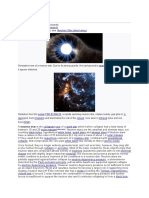Supernova
Supernova
Uploaded by
parin advaniCopyright:
Available Formats
Supernova
Supernova
Uploaded by
parin advaniOriginal Description:
Copyright
Available Formats
Share this document
Did you find this document useful?
Is this content inappropriate?
Copyright:
Available Formats
Supernova
Supernova
Uploaded by
parin advaniCopyright:
Available Formats
A supernova is a stellar explosion that briefly outshines an entire galaxy, radiating as much energy
as the Sun or any ordinary star is expected to emit over its entire life span, before fading from view
over several weeks or months.[1] The extremely luminous burst ofradiation expels much or all of a
star's material[2] at a velocity of up to 30,000 km/s (10% of the speed of light), driving a shock
wave[3]into the surrounding interstellar medium. This shock wave sweeps up an expanding shell of
gas and dust called a supernova remnant. A great proportion of primary cosmic rays comes from
supernovae.[4]
Supernovae are more energetic than a nova. Nova means "new" in Latin, referring to what appears
to be a very bright new star shining in the celestial sphere; the prefix "super-" distinguishes
supernovae from ordinary novae, which are far less luminous. The word supernova was coined
by Walter Baade and Fritz Zwicky in 1931.[5] It is pronounced /suprnov/ with the
plural supernovae/suprnovi/ or supernovas (abbreviated SN, plural SNe after "supernovae").
Supernovae can be triggered in one of two ways: by the sudden re-ignition of nuclear fusion in
a degenerate star; or by thegravitational collapse of the core of a massive star. In the first case, a
degenerate white dwarf may accumulate sufficient material from a companion, either
through accretion or via a merger, to raise its core temperature, ignite carbon fusion, and
trigger runaway nuclear fusion, completely disrupting the star. In the second case, the core of
a massive star may undergo sudden gravitational collapse, releasing gravitational potential
energy that can create a supernova explosion.
The last directly observed supernova in the Milky Way was Kepler's Star of 1604 (SN
1604); remnants of two more recent supernovae have been found retrospectively. Nevertheless,
observations in other galaxies indicate that supernovae occur on average about three times every
century in the Milky Way.[6]They play a significant role in enriching the interstellar medium with
higher mass elements.[7] Furthermore, the expanding shock waves from supernova explosions can
trigger the formation of new stars.[8][9]
You might also like
- Supernova: From Wikipedia, The Free EncyclopediaDocument1 pageSupernova: From Wikipedia, The Free EncyclopediaDean Joyce AlborotoNo ratings yet
- Supernova: Nova (Plural Novae) Means "New" inDocument16 pagesSupernova: Nova (Plural Novae) Means "New" inlyn_celzNo ratings yet
- Supernova: History of Supernova ObservationDocument18 pagesSupernova: History of Supernova ObservationAnita AfriNo ratings yet
- Type Ia SupernovaDocument22 pagesType Ia Supernovasipobey750No ratings yet
- SupernovaDocument7 pagesSupernovaAndreaNo ratings yet
- What Is A SupernovaDocument3 pagesWhat Is A Supernovaapi-3825233No ratings yet
- Mechanism of SupernovaeDocument15 pagesMechanism of SupernovaeNived ChristopherNo ratings yet
- NebulaDocument1 pageNebulaTamil ManiNo ratings yet
- Supernovae Nasa Imagine ArticleDocument1 pageSupernovae Nasa Imagine Articleapi-26963416No ratings yet
- Honours Course in Space ScienceDocument17 pagesHonours Course in Space ScienceGadhadar ReddyNo ratings yet
- Association Between Supernova Remnants and PulsarsDocument16 pagesAssociation Between Supernova Remnants and PulsarsGadhadar ReddyNo ratings yet
- Black Hole: From Wikipedia, The Free EncyclopediaDocument6 pagesBlack Hole: From Wikipedia, The Free EncyclopediaSumathi AmbunathanNo ratings yet
- SupernovasDocument155 pagesSupernovasagarcia1060No ratings yet
- SPACE Notes 4 and 5Document16 pagesSPACE Notes 4 and 5Shashwat TripathiNo ratings yet
- SupernovaDocument2 pagesSupernovaveena bhatNo ratings yet
- Supernova and PulsarsDocument15 pagesSupernova and PulsarsGadhadar ReddyNo ratings yet
- SuperNova Essay - Completed Spring Semester of 2021Document6 pagesSuperNova Essay - Completed Spring Semester of 2021Cloud SurgeonNo ratings yet
- Neutron Star: For The Story by Larry Niven, SeeDocument15 pagesNeutron Star: For The Story by Larry Niven, SeeDhaval MistryNo ratings yet
- Malou Ass Tungkol Sa StarsDocument4 pagesMalou Ass Tungkol Sa Starstom_donato_1No ratings yet
- Neutron Star: A White Stellar EvolutionDocument21 pagesNeutron Star: A White Stellar Evolutionhoney30389No ratings yet
- SupernovaDocument3 pagesSupernovaexxaiter333No ratings yet
- Space: The UniverseDocument9 pagesSpace: The UniverseIshita SharmaNo ratings yet
- Crab NebulaDocument20 pagesCrab NebulaAbraxazNo ratings yet
- Types of SupernovaeDocument7 pagesTypes of SupernovaeYusranNo ratings yet
- Topic: Super Nova: Observation HistoryDocument20 pagesTopic: Super Nova: Observation HistoryJohn JovonovichNo ratings yet
- Evolution of StarsDocument3 pagesEvolution of StarsCln CatadNo ratings yet
- Stars, Galaxies, and The Universe: For Centuries PDocument5 pagesStars, Galaxies, and The Universe: For Centuries PMohamed S. Hamed100% (1)
- Chandra Harvard Edu Pdf5Document6 pagesChandra Harvard Edu Pdf5shaniladwiNo ratings yet
- STARSDocument21 pagesSTARSNicolás Muñoz GarcíaNo ratings yet
- Stellar Evolution - The Birth, Life, and Death of A StarDocument2 pagesStellar Evolution - The Birth, Life, and Death of A StarKaiNo ratings yet
- Black Holes: The Story of Collapsing Stars. First Edition. Pankaj S. JoshiDocument20 pagesBlack Holes: The Story of Collapsing Stars. First Edition. Pankaj S. Joshiarshivaji100% (1)
- Supernova - WikipediaDocument27 pagesSupernova - WikipediaYn FoanNo ratings yet
- English AssignmentDocument4 pagesEnglish AssignmentBrylle Jairus LacamenNo ratings yet
- Gravitational-Waves-Volume-2-Astrophysics-And - Cosmology PDFDocument823 pagesGravitational-Waves-Volume-2-Astrophysics-And - Cosmology PDF王芮琪No ratings yet
- ErumDocument9 pagesErumIrshad SheikhNo ratings yet
- Indian Space Research Organisation:: StarDocument4 pagesIndian Space Research Organisation:: StarKishore RaveendiranNo ratings yet
- OMP98Document3 pagesOMP98jafasoh293No ratings yet
- Stellar EvolutionDocument13 pagesStellar EvolutionJayeeta DasNo ratings yet
- 64b29b4d5ee64f00182d7017 - ## - Geography 07 - Daily Class Notes - (UPSC Titan English)Document6 pages64b29b4d5ee64f00182d7017 - ## - Geography 07 - Daily Class Notes - (UPSC Titan English)Utkarshaa SinghNo ratings yet
- How Do Stars Form in A Nebula?Document2 pagesHow Do Stars Form in A Nebula?sttiching video roothikaNo ratings yet
- QuasarDocument13 pagesQuasarAbraxazNo ratings yet
- Nova NakDocument11 pagesNova NakChitikala RajeshNo ratings yet
- 6.2 Star and The Universe-HandoutDocument4 pages6.2 Star and The Universe-HandoutMohammad Wajeeh MohsinNo ratings yet
- Supernovae (Clayton, Uhl)Document2 pagesSupernovae (Clayton, Uhl)Catie WootenNo ratings yet
- g485 5 5 1 Structure of The UniverseDocument15 pagesg485 5 5 1 Structure of The Universeapi-236179294No ratings yet
- NebulaDocument31 pagesNebulashaluNo ratings yet
- Are We Really All Made of Stars?: Sagan Famously StatedDocument8 pagesAre We Really All Made of Stars?: Sagan Famously StatedYASSINNo ratings yet
- GeographyDocument173 pagesGeographysadgh gyuhj100% (2)
- Nostradamus Volume 12 of 17: And Explanations of Afterlife ExperiencesFrom EverandNostradamus Volume 12 of 17: And Explanations of Afterlife ExperiencesNo ratings yet
- 1 Wasddddddddd 12 W 31Document2 pages1 Wasddddddddd 12 W 31Linigha mcuigghaNo ratings yet
- Space Knowledge AnswersDocument1 pageSpace Knowledge AnswersM KNo ratings yet
- How The Universe, Solar System and Earth Began: Robin Oliver B. MagsombolDocument7 pagesHow The Universe, Solar System and Earth Began: Robin Oliver B. MagsombolsiennNo ratings yet
- Civil Services GeographyDocument152 pagesCivil Services Geographynirmalnsc100% (1)
- Dalman MidtermDocument6 pagesDalman MidtermCatherine TaganileNo ratings yet
- Celestial Fireworks SNRDocument3 pagesCelestial Fireworks SNRSherre BoothmanNo ratings yet
- Life Cycke of Star InformationDocument14 pagesLife Cycke of Star InformationJasmineNo ratings yet
- General Astronomy Project: Astro 102Document29 pagesGeneral Astronomy Project: Astro 102Nida AbabtainNo ratings yet
- SupernovaDocument54 pagesSupernova2YeseniaNo ratings yet
- 6.2.2 StarsDocument6 pages6.2.2 StarsIshimwe HabiyakareNo ratings yet
- Meteoric astronomy: A treatise on shooting-stars, fire-balls, and aerolitesFrom EverandMeteoric astronomy: A treatise on shooting-stars, fire-balls, and aerolitesNo ratings yet
- Small Scale ReviewDocument14 pagesSmall Scale Reviewparin advaniNo ratings yet
- Gravity or Gravitation Is ADocument1 pageGravity or Gravitation Is Aparin advaniNo ratings yet
- SolidWize CSWP Sample Exam 2 Segment 3 PDFDocument16 pagesSolidWize CSWP Sample Exam 2 Segment 3 PDFparin advani100% (3)
- JungleJuice FeedChartDocument1 pageJungleJuice FeedChartparin advaniNo ratings yet
- SpacetimeDocument2 pagesSpacetimeparin advaniNo ratings yet
- AsteroidsDocument1 pageAsteroidsparin advaniNo ratings yet
- Science (From: Laws of NatureDocument1 pageScience (From: Laws of Natureparin advaniNo ratings yet
- Shock Waves Sound Explosion BulletDocument1 pageShock Waves Sound Explosion Bulletparin advaniNo ratings yet
- Giant Star Solar Masses Stellar Evolution Spectral Types Carbon StarsDocument1 pageGiant Star Solar Masses Stellar Evolution Spectral Types Carbon Starsparin advaniNo ratings yet
- Longitudinal and Transverse WavesDocument1 pageLongitudinal and Transverse Wavesparin advaniNo ratings yet
- Supersonic Speed Is A Rate of Travel of An Object That Exceeds TheDocument1 pageSupersonic Speed Is A Rate of Travel of An Object That Exceeds Theparin advaniNo ratings yet
- Fluid Resistance Shear Stress Tensile Stress Honey WaterDocument1 pageFluid Resistance Shear Stress Tensile Stress Honey Waterparin advaniNo ratings yet
- Ultraviolet (UV) Light IsDocument1 pageUltraviolet (UV) Light Isparin advaniNo ratings yet
- Fluid Dynamics Friction Fluid Friction Forces Solid FrictionDocument1 pageFluid Dynamics Friction Fluid Friction Forces Solid Frictionparin advaniNo ratings yet
- Wave Speed of Sound Liquid Gas Plasma Fluid Pressure Temperature Density Expansion Fan Solitons Sonic BoomDocument1 pageWave Speed of Sound Liquid Gas Plasma Fluid Pressure Temperature Density Expansion Fan Solitons Sonic Boomparin advaniNo ratings yet
- Astrophysics (from Greek astron, στρον "star", andDocument1 pageAstrophysics (from Greek astron, στρον "star", andparin advaniNo ratings yet
- The Four Fundamental States of Matter Solid Liquid Plasma Noble Gas Neon Elemental Oxygen Compound Carbon Dioxide Mixture AirDocument1 pageThe Four Fundamental States of Matter Solid Liquid Plasma Noble Gas Neon Elemental Oxygen Compound Carbon Dioxide Mixture Airparin advaniNo ratings yet
- Physics Mass Velocity State of Rest Accelerate Magnitude Direction Vector SI Unit Newtons Newton's Second Law Rate Momentum Acceleration MassDocument1 pagePhysics Mass Velocity State of Rest Accelerate Magnitude Direction Vector SI Unit Newtons Newton's Second Law Rate Momentum Acceleration Massparin advaniNo ratings yet
- VacuumDocument1 pageVacuumparin advaniNo ratings yet
- StringDocument1 pageStringparin advaniNo ratings yet
- White Dwarf Degenerate DwarfDocument1 pageWhite Dwarf Degenerate Dwarfparin advaniNo ratings yet
- Wind Is The Flow of Gases On A Large Scale. On The Surface of The Earth, Wind Consists of The BulkDocument2 pagesWind Is The Flow of Gases On A Large Scale. On The Surface of The Earth, Wind Consists of The Bulkparin advaniNo ratings yet
- Calculus of VariationsDocument1 pageCalculus of Variationsparin advaniNo ratings yet
- RocketDocument1 pageRocketparin advaniNo ratings yet
- Physics Deform ForcesDocument1 pagePhysics Deform Forcesparin advaniNo ratings yet
- Astrophysics (From Greek Astron: Which? Why?Document1 pageAstrophysics (From Greek Astron: Which? Why?parin advaniNo ratings yet
- Theory of Relativity Events ObserversDocument1 pageTheory of Relativity Events Observersparin advaniNo ratings yet
- Visible Light (Commonly Referred To Simply As Light) IsDocument1 pageVisible Light (Commonly Referred To Simply As Light) Isparin advaniNo ratings yet
- Space Is The Boundless Three-Dimensional Extent in Which: KhoraDocument1 pageSpace Is The Boundless Three-Dimensional Extent in Which: Khoraparin advaniNo ratings yet
- PhysicsDocument1 pagePhysicsparin advaniNo ratings yet

























































































